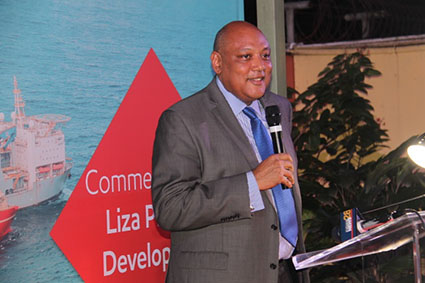ExxonMobil remains on target to begin oil production offshore Guyana by March, 2020, following the start of development drilling for its Liza Phase 1 project.
In a statement issued yesterday, the oil major said development drilling began in May for the first of 17 wells planned for Phase 1, laying the foundation for production startup in 2020.
“The work our teams have done in Guyana is remarkable,” Liam Mallon, President of ExxonMobil Development Company was quoted as saying. “We are well on our way to producing oil less than five years after our first discovery, which is well ahead of the industry average for similar projects. The Liza development and future projects will provide significant economic benefits to Guyana.”
The statement noted the company and its co-venturers have so far discovered estimated recoverable resources of more than 3.2 billion oil-equivalent barrels on the Stabroek Block. It added that Liza Phase 1 is expected to generate over $7 billion in royalty and profit oil revenues for Guyana over the life of the project over its lifetime and that additional benefits will accrue from other development projects now being planned.
“Liza Phase 1 involves the conversion of an oil tanker into a floating, production, storage and offloading (FPSO) vessel named Liza Destiny, along with four undersea drill centers with 17 production wells. Construction of the FPSO and subsea equipment is underway in more than a dozen countries.
“Liza Destiny will have a production capacity of 120,000 barrels of oil per day. A second FPSO with a capacity of 220,000 barrels per day is being planned as part of the Liza Phase 2 development, and a third is under consideration for the Payara development. Together, these three developments will produce more than 500,000 barrels of oil per day,” the statement added.
Strategically supporting
Later, at an event held at the Cara Lodge last evening for the launch of the Liza Phase 1 Development, Exxon’s Country Manager Rod Henson talked up the company’s investment in the country’s economy and its growth of the local business capacity.
Henson said there has been a three-pronged approach focused on workforce development, supplier development and strategic investments to support these efforts.
Henson stressed that the company has been strategically supporting local content efforts and pointed to the investments made in the creation and sustaining of the Centre for Local Business Development (CLBD), which opened here last July.
“Not only does the centre manage the Supplier Registration Portal, which incidentally had 855 Guyanese companies—that’s 73%, registered at the end of last year—but it also runs courses in Energy Literacy and Content Training for Government Agencies,” he said.
Further, he noted that the company’s prime contractors engage with the CLBD and utilise local vices to build local capacity. “Even in these early days local subcontractors have been signed up for this development. Noble Drilling have a three-year contract and have subcontracted JSL for staffing…TechnipFMC is engaging with local suppliers to evaluate and develop a local supply chain for in-country services. SBM has been maximising local participation in courses and advertising tenders for on and offshore manpower services. SAPIEM has recently signed a contract with John Fernandes Wharf and GYSBI [Guyana Shore Base Inc.] has been hiring for a variety of positions. It really is the knock-on effect from our main contractors that brings significant value to the country,” he said.
Reiterating statements made to this newspaper on Exxon’s local content efforts for the first quarter of this year, he noted that over US$14 million was spent on Guyanese suppliers and that together with their contractors, the company utilised 262 Guyanese registered suppliers, 227 of which are locally-owned.
However, he was quick to point out that “of course supplier spending is just one indicator” of the company’s local content efforts.
We continue to build our Guyanese workforce, which presently totals 585 or 52%, and our local office grew to 40 employees of which 70% are Guyanese, including two in management positions,” Henson also said.
He noted that Guyanese have joined the Esso Exploration and Production Guyana Limited (EEPGL) team as Community Relations Manager, Operations Integrity Management Systems Coordinator; Safety, Health and Environment Coordinator, Transportation Coordinator, Facilities Coordinator, Materials Management Coordinator and Facility Engineers.
Opportunity
Meanwhile, giving brief remarks on behalf of government at the event were Minister of Natural Resources Raphael Trotman and Minister of Business Dominic Gaskin.
Trotman said Guyana has a “jubilee opportunity” and “second chance” to erase the stigmas associated with it, such as “Third World, backward and undeveloped,” and to work towards building a Guyana where “Every person, every man woman and child can benefit from the bounty we are about to receive.”
Trotman also used his address to continue government’s defence of the renegotiated production sharing agreement with Exxon and its partners, saying that it has the same benefits as a number of other companies that are here. “ExxonMobil, a company that has been in Guyana since 1999, has the same or very similar contractual terms as was Anadarko, CGX, REPSOL, Ratio, Eco-Atlantic and Mid Atlantic. In that regard, they will enjoy the same rights and obligations as every other company that has been contracted by the government to explore and develop our hydrocarbons,” he said. “That they were the first to find a large deposit should not redefine their contractual terms or place them in any position less than that enjoyed prior to discovery. For government to do otherwise is not how responsible or how well-organised and governed states function,” he added.
For his part, Gaskin said that be believed that the country would be positively and significantly transformed by the revenues generated from the oil and gas that the Liza development and other projects bring.






